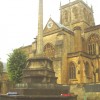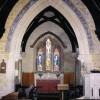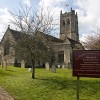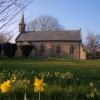From almost the earliest antiquity, the parish of Rempstone in Purbeck has been an area of unresolved enigma and dark secrets. Possibly over four thousand years ago Neolithic farmers or traders created a track, possibly a trade route, along the north flank of the Chalk ridge called Nine Barrow Down, connecting the mound of Corfe Castle with the coast at Studland. Centuries later, in the second millennium BCE (Before the Common Era,) pagan priests of the Bronze Age constructed a ceremonial circle of nine stones a little to the north of the hogsback track way, later much damaged by medieval clay workings. The remaining stones today stand half hidden in a block of woodland on the manor estate. Along the ridge itself are the nine barrow graves of Wessex chieftains, while on the hills opposite Rempstone Hall are two enigmatic earthworks of unknown date and undefined purpose.
Then in Iron Age and Roman times the parish became caught up in the plundering of Purbeck’s wealth in extractive mineral resources, as its heathland was turned into an industrial landscape for the extraction and exporting of iron, clay, shale and finished pottery goods. At Church Knowle, only a quarter of a mile west of the manor, lie the remains of a Romano-British villa. By the time of the area’s industrialisation in the Middle Ages, Rempstone was already an ancient manor and hamlet, becoming a farmhouse in the 16th century.
Rempstone Hall itself is an isolated house two-and-a-half miles from the nearest villages of Corfe and Studland. Situated to the east is Kingswood Farm, while to the west lie Rollington and Brenscombe Farms. Over two centuries the Hall has become impounded by mature woodland of oak, chestnut, birch and pine, planted in 1790.
Regarding the name Rempstone, several options have been put forward as to its origin. According to historian John Hutchins the earliest, or one of the earliest, Lords of the Manor was Robert Rempston, who died in 1464, though it has been suggested that he adopted his family name from the pre-existing place name, not the other way round. Another popular theory is that George Trenchard, who occupied the house in the 17th century, called it Rempscombe after the Old English word combe, meaning “narrow valley.” However, as the “valley” from Corfe to Studland is only one-sided, grading into the heath and is anything but narrow, it is difficult to see how this interpretation can be accepted.
Etymologist Eilert Ekwall has argued that Rempstone may derive from the Old English “Hrempi’s Tun,” meaning the home or village of one called Hrempi, though there is no record of such a person; or else it derives from “Hrimpan” (wrinkled.) Most likely however is “Hring-Stun” – Old English for Stone Ring – surely significant, since the stone circle lies only 300 yards from Rempstone Hall.
Whether or not Rempston was the first Lord of the Manor, his immediate successors seem to have been the Miller family of Corfe, who in turn relinquished the estate to the Uvedales of Sherborne. The estate then passed to the Framptons of Buckland. By 1664 Rempstone was in the hands of the Trenchards of Wolfeton, and then finally (i.e. up until the latter 18th century) becoming the possession of the Rose family of Dorchester.
But the modern well-documented history of the estate begins with the highly interesting political and military Calcrafts, a family that had its roots at Grantham in Lincolnshire. The Calcrafts established a dynasty that lasted from 1726, when the second John Calcraft was born, until the last male Calcraft died in 1901. John Calcraft the younger was the supposed son of another John Calcraft of Grantham, though it is more likely he was actually an illegitimate son of Sir Henry Fox, father of the famous Tory politician Charles James Fox. John himself became a prominent Whig politician and MP for Wareham, who bought up much of its property after the town’s great fire in 1762.
In the 18th and 19th centuries the Rempstone estate extended in a broad band right across the Isle of Purbeck from the southern shore of Poole harbour to the coast at Worth Matravers and Winspit.
John Calcraft began a relationship with Elizabeth Bride and bought Rempstone Hall from the last of the Dorchester Rose’s in 1757. Calcraft however was already in possession of several other estates in Lincolnshire, Kent, Wiltshire and elsewhere. At that time Rempstone Hall was a considerably smaller house, consisting of the original 16th and 17th century core building. During the time of John’s son, the Rt.Hon. John Calcraft MP and his wife Lady Caroline Montagu Calcraft no major alterations took place, but in the early 1790’s John Hales Calcraft, John the second’s grandson, considerably enlarged Rempstone by the addition of another wing, ever since known as Lower Rempstone to distinguish it from the earlier Upper Rempstone. More minor additions to the Hall were made in the 1830’s.
During the time the manor was in the ownership of the Calcrafts, the highly formalised, labour-intensive system for household management of the gentry came to full fruition. For example the 1861 census records that Rempstone Hall had ten resident servants, two footmen, two ladies maids, a cook, a cookman, a butler, a scullery maid, and a carpenter. This tally did not include non-resident daily workers and outside servants. Like many country houses, Rempstone was effectively a self-contained self-sufficient community producing much of its own food.
The last of the Calcrafts was William Montagu Calcraft, who died in 1901. His successor was a nephew, Guy Montagu Marston RN, the son of William’s sister Katherine and the Revd. Charles D Marston. Marston carried out repairs to the house in 1906 and 1919, where drainpipes bearing his monograph date from this time. Although outwardly respectable, Marston is better known for his friendships with the poet Rupert Brooke and the notorious occultist Aleister Crowley, who performed ritualistic magic at the house. In 1927 Rempstone Hall came into the possession of Major Douglas Claude Dudley (Jack) Ryder, and it was he and his family who were occupying the house at the outbreak of war in 1939.
At the end of 1940 the military requisitioned the west-end of the house. The squash court became a canteen. Bren-gun carriers were em-parked in the driveway. By the end of 1942 the army had taken over the entire hall. The windows of Rempstone had to be protected with sandbags. One night in 1940 the household received a phone call to say church bells were being rung because it was believed an invasion was imminent. Rempstone Hall itself was never hit, though during the Battle of Britain several bombs fell nearby.
When the war ended many unexploded bombs and shells had to be cleared from the surrounding area. Rempstone continued to be occupied by army and navy personnel until 1949, by which time much interior and exterior restoration had to be carried out. At this time also, the connection between Lower and Upper Rempstone was broken and the lower part sub-let to tenants. Tourist coaches on the road would point out that Rempstone was the house where the D-Day landings were planned, though written proof of this has not been found. However, Rempstonee Hall as the local Army HQ is thought to have been visited by at least some of the wartime leaders.
Rempstone Hall is a residence that over its centuries has acquired more than one ghost, including that, it is said, of the religiously fanatical Lady Caroline Calcraft. Possibly the supernatural disturbances and darker goings-on can be attributed to Cowley’s evil magic rituals, also to an underground stream said to flow beneath the house. This is entirely credible, for there is one other feature that underground streams have been particularly associated with: megalithic stone circles.



